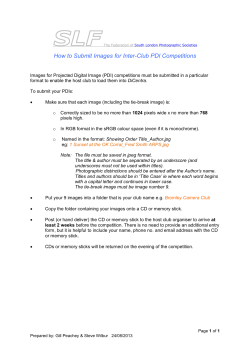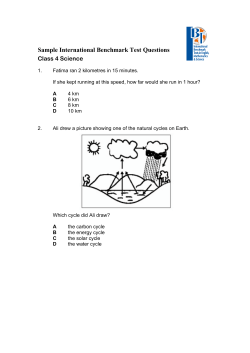
Examining Forces
Examining Forces Activity 1 Equipment Blank Piece of Paper – to record observations and take notes Writing Instrument – to record observations and take notes Bike (if available) Procedure 1. Set up a data table, similar to the one shown below, to record your observations for the five parts of the bicycle. 2. Give your data table a title. 3. Using the diagram of the bicycle provided fill out the data table based on the descriptions. * Note, after completing the procedure and the discussion there is probably a lot of time left in class. You may wish to use this time to try to name more parts, not indicated already in your table. If you do so, add these to your data table and they will count as extras towards the bottom row of your rubric. Observations Part Name Letter What Causes the Force? Type of Strength Needed Discussion Identify an additional part (not labelled above) of the bicycle that might fail because it has too little: 1. Tensile Strength 3. Shear Strength 2. Compressive Strength 4. Torsion Strength Examining Forces Activity 2 Equipment Blank Piece of Paper – to record observations and take notes Writing Instrument – to record observations and take notes Bendy Straw Popsicle Stick Safety Goggles Procedure 1. Make a data table with four quadrants, taking up at least half of a page, similar to the one below. 2. Give your data table a title. 3. Place the unbent straw on your table and draw the pleated section, large and detailed, in the top left quadrant of your data table. Label this diagram “Compression.” 4. Gently stretch the straw and then draw the pleated section, again, large and detailed, in the top right quadrant of your data table. Label this diagram “Tension”. 5. Gently bend the straw so that it makes a right angle (90 degrees) and then draw, in detail, the pleated section in the bottom left quadrant of your data table. Label one side of the pleats “Tension” and the other side “Compression”. You will need to decide which side is which. 6. Everyone at your table is to put on safety goggles at this point. 7. Hold a popsicle stick straight in your hands. Place your thumbs in the bottom middle of the popsicle stick, and, holding the sides, gently and slowly push the middle of the popsicle stick upwards until it just starts to break – do not allow it to separate into two pieces. 8. Draw, in detail, the middle section of the popsicle stick, both before applying the force, and after applying the force, in the bottom right quadrant of your data table. Label the areas where tension occurred and where compression occurred. Observations Note: Actual table should be much larger. Examining Forces Activity 3 Equipment Blank Piece of Paper – to record observations and take notes Writing Instrument – to record observations and take notes Wash Cloth Bucket Graduated Cylinder Funnel Procedure 1. 2. 3. 4. Make a data table, similar to the one shown below, to record your observations. Give your data table a title. Place the wash cloth in a full sink of water. Remove the wash cloth and, while holding it over the bucket, squeeze out as much water as you can WITHOUT twisting it. 5. Pour the water, from the bucket, into the graduated cylinder and record the volume of water. 6. Repeat steps 3 to 5, however this time twist the towel, but not squeeze it, to get as much water out as you can. * Note, at this point there is probably a lot of time left in class, you may wish to use this time to try more methods, not indicated in the procedure. If you do so, add these to your data table and they will count as extras towards the bottom row of your rubric. Observations Method Amount of Water (mL) Discussion Which method squeezed out more water? What type of force are you applying in each situation? Examining Forces Activity 4 Equipment Blank Piece of Paper – to record observations and take notes Writing Instrument – to record observations and take notes Meter Stick 15 cm Length Each - Thread, Fishing Line, Dental Floss and String Variety of Spring Scales Safety Goggles Procedure 1. Make a data table, similar to the one shown below, to record your observations. 2. Give your data table a title. 3. Tie each of the four materials (thread, fishing line, dental floss and string) into individual loops. Be sure the knot is tight. 4. Place two desks approximately 2 cm apart with a gym mat underneath the gap. 5. Place one of the loops over the meter stick, and place the meter stick between the two desks (see picture below). 6. Everyone in your group is to put on safety goggles at this point, 7. Use the spring scale to pull the loop down until the material breaks. Record the force that was needed to break the material. Note: You may find that more than 45 N of force is needed, if this is the case, attach 2 spring scales to your loop and pull on both. You will need to add the two forces together. 8. Repeat steps 5 and 6 for each of the materials. 9. Choose one material and braid three pieces of that material together. Repeat steps 5 and 6 with the braided material. Observations Material Break Force (N)
© Copyright 2025












